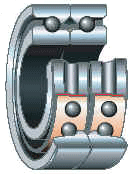Ball Screw Support Bearings Review
Bearings Application Knowledge Menu
A ball screw is a mechanical linear actuator that translates rotational motion to linear motion with little friction. A threaded shaft provides a helical raceway for ball bearings which act as a precision screw. As well as being able to apply or withstand high thrust loads, they can do so with minimum internal friction. They are made to close tolerances and are therefore suitable for use in situations in which high precision is necessary. The ball assembly acts as the nut while the threaded shaft is the screw. In contrast to conventional leadscrews, ballscrews tend to be rather bulky, due to the need to have a mechanism to re-circulate the balls.
Another form of linear actuator based on a rotating rod is the threadless ballscrew, a.k.a. "rolling ring drive". In this design, three (or more) rolling-ring bearings are arranged symmetrically in a housing surrounding a smooth (thread-less) actuator rod or shaft. The bearings are set at an angle to the rod, and this angle determines the direction and rate of linear motion per revolution of the rod. An advantage of this design over the conventional ballscrew or leadscrew is the practical elimination of backlash and loading caused by preload nuts.
Ball screw support bearings are specially configured and designed to provide extra axial strength, accuracy and elevated thrust loading for use with ball or lead screws. Typically, ball screw support type bearings are angular contact bearings, which are available in duplex, triplex and quadruplex configurations that includes single and double-row designs with a variety of mounting configurations. Other ball screw support type bearings contain separate thrust and radial roller bearings in a single assembly. Both Metric Series and Inch Series are available.
 |
Typical tolerance and fit specification is line-to-line to loose for the installation shaft and housing. Bearings may be supplied in sets which are clearly match-marked on their outside diameter surfaces to indicate correct positioning of each bearing.
Important considerations when specifying ball screw support bearings are, load ratings, size - design envelope requirements, and operationing speed. Most manufacturers provide detail load and life rating specifications for thier bearing products.